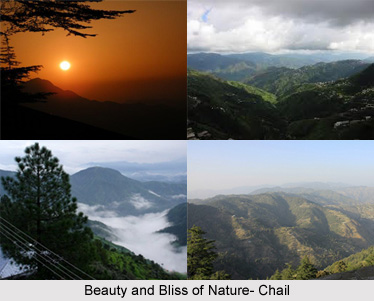 Chail is a little mountainous heaven 45 kms from Shimla. It was the summer capital of the Maharaja of Patiala before Independence. The forests near Chail in Himachal Pradesh have many species of birds and deer. Chail is known for its cricket pitch, which is the highest cricket ground in the world.
Chail is a little mountainous heaven 45 kms from Shimla. It was the summer capital of the Maharaja of Patiala before Independence. The forests near Chail in Himachal Pradesh have many species of birds and deer. Chail is known for its cricket pitch, which is the highest cricket ground in the world.
This idyllic resort, set amidst scented forests of pine and deodar, was once the summer resort of the maharajas of Patiala. Located on a wooded spur, Chail (2,150 m) overlooks the Sutlej Valley. Shimla and Kasauli are also visible and at night their twinkling lights seem part of the starlit sky.
The palace of the maharajas, built in the late 19th century and the pretty cottages of the complex - that once accommodated the ADCs and guests of the royal party - are now part of a charming holiday resort.
Chail has lovely walks and trails that meander through the dense pine forests - the home of barking deer, wild boar, pheasant and a variety of birds. Forest rest houses make overnight halts possible. For those interested in sports, Chail has fine tennis and squash courts and a putting green. There are excellent spots along the Gaura River with opportunities for anglers to tangle with the Himalayan mahaseer. Chail has also the highest cricket ground in the world - 2,250 m above sea level.
Chail Sanctuary
Chail is a beautiful hill station and a popular resort. The deodar and oak forests and grasslands around the town are part of the sanctuary. One can see sambhar, ghoral and cheer phesants at Blossom and Jhaja - where there are pheasant breeding centres. Barking deer and khalij pheasant are often spotted at dusk and dawn in the sanctuary. Treks from Chail to Gaura and Chail to Jhaja are popular.
Visting Information
The nearest airports of Chail are Shimla and Chandigarh. The nearest railhead is Kalka (86 Km). Chail is accessible by road from Kalka via Kandaghat which is 32 km short of Shimla, on the Kalka - Shimla Highway. Kandaghat - Chail is 29 km.



















